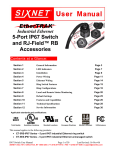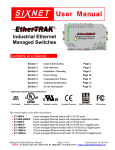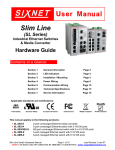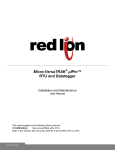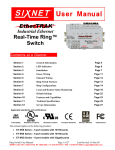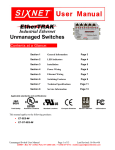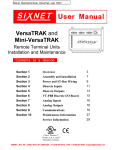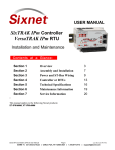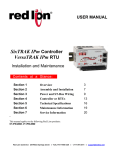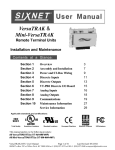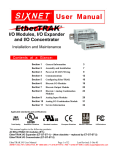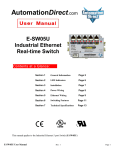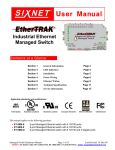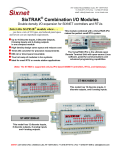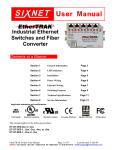Download Micro-IPm User Manual
Transcript
Micro-VersaTRAK® µIPm™ RTU and Datalogger Installation and Maintenance Contents at a Glance: Section 1 Overview 3 Section 2 Assembly and Installation 7 Section 3 Power Wiring 9 Section 4 I/O Wiring 10 Section 5 Communications 12 Section 6 Technical Specifications 15 Section 7 Maintenance Information 18 Section 8 Service Information 19 Applicable standards and certifications: Total Quality Hazardous Locations Standard Locations European Directives Marine & Offshore US Emissions This manual applies to the following SIXNET products: VT-UIPM-XXX-H Micro-VersaTRAK µIPm RTU Note: In this manual, this unit is also referred to as the Micro-IPm or µIPm. SIXNET Micro-VersaTRAK µIPm User Manual Page 1 Last Revised: 4-May-05 SIXNET • Box 767 • Clifton Park, NY 12065 USA • +1 (518) 877-5173 • FAX +1 (518) 877-8346 • [email protected] PROTECTED TECHNOLOGY POLICY SIXNET protects your investment in SIXNET systems with long-term planned technology and our unique Protected Technology Policy. We will continue to support the specified capabilities of standard SIXNET products for at least five years. We plan each product improvement and new feature to be upward compatible with existing designs and installations. Our goals are to make each new software release bring new power to your SIXNET systems and have every existing feature, applications program and data file continue to work. We protect your investment even further with a liberal five-year trade-in policy. Exchange standard products for upgraded versions of the same product to take advantage of new features and performance improvements at any time for five years. A prorated trade-in allowance will be given for your existing equipment. SIXNET protects your longterm productivity with state-of-the-art planned technology and continued support. STATEMENT OF LIMITED WARRANTY SIXNET, manufacturer of SixTRAK, VersaTRAK, RemoteTRAK and EtherTRAK products, warrants to Buyer that products manufactured by SIXNET will be free from defects in material and workmanship. SIXNET’s obligation under this warranty will be limited to repairing or replacing, at SIXNET’s option, the defective parts within 1 year of the date of installation, or within 18 months of the date of shipment from the point of manufacture, whichever is sooner. Products may be returned by Buyer only after permission has been obtained from SIXNET. Buyer will prepay all freight charges to return any products to the repair facility designated by SIXNET. This limited warranty does not cover losses or damages that occur in shipment to or from Buyer or due to improper installation, maintenance, misuse, neglect or any cause other than ordinary commercial or industrial applications, This limited warranty is in lieu of all other warranties whether oral or written, expressed or implied. SIXNET’s liability shall not exceed the price of the individual unit which is the basis of the claim. In no event shall SIXNET be liable for any loss of profits, loss of use of facilities or equipment or other indirect, incidental or consequential damages. INSTALLATION AND HAZARDOUS AREA WARNINGS These products should not be used to replace proper safety interlocking. No software-based device (or any other solidstate device) should ever be designed to be responsible for the maintenance of consequential equipment or personnel safety. In particular, SIXNET disclaims any responsibility for damages, either direct or consequential, that result from the use of this equipment in any application. All power, input and output (I/O) wiring must be in accordance with Class I, Division 2 wiring methods and in accordance with the authority having jurisdiction. WARNING – EXPLOSION HAZARD – SUBSTITUTION OF COMPONENTS MAY IMPAIR SUITABILITY FOR CLASS 1, DIVISION 2. WARNING – EXPLOSION HAZARD – WHEN IN HAZARDOUS LOCATIONS, DISCONNECT POWER BEFORE REPLACING OR WIRING MODULES. WARNING – EXPLOSION HAZARD – DO NOT DISCONNECT EQUIPMENT UNLESS POWER HAS BEEN SWITCHED OFF OR THE AREA IS KNOWN TO BE NONHAZARDOUS. Note: All information in this document applies to the Micro-VersaTRAK µIPm RTU, except where otherwise noted. Refer to the electronic help system in the SIXNET I/O Tool Kit software for detailed product specifications and configuration settings. SIXNET Micro-VersaTRAK µIPm User Manual Page 2 Last Revised: 4-May-05 SIXNET • Box 767 • Clifton Park, NY 12065 USA • +1 (518) 877-5173 • FAX +1 (518) 877-8346 • [email protected] Section 1 Introduction Overview The products covered by this manual are designed for use in industrial control and data acquisition systems. Refer to the SIXNET Electronic catalog and the individual data sheets for complete features and benefits. This user manual covers the aspects of hardware installation and maintenance for the Micro-IPm. For software features and capabilities please refer to the electronic help system in the SIXNET I/O Tool Kit software. A typical SIXNET station consists of an AC to DC power supply; a SIXNET controller or RTU (such as the models covered by this manual) and I/O modules. The Micro-IPm can interface with I/O modules via Ethernet (EtherTRAK I/O), or RS485 (RemoteTRAK or EtherTRAK I/O). Just about any combination of these components along with third party hardware and software can be used to make a system. These SIXNET products offer practically unlimited I/O expansion and communication connectivity. SIXNET Micro-VersaTRAK µIPm User Manual Page 3 Last Revised: 4-May-05 SIXNET • Box 767 • Clifton Park, NY 12065 USA • +1 (518) 877-5173 • FAX +1 (518) 877-8346 • [email protected] Quick Getting Started Guide Following these steps will make installation and start-up easier. n Mount the Hardware If you purchased a TrakPak packaged system, the complete enclosure is ready for installation on any flat surface. If you purchased individual components, refer to the following sections of this manual or other appropriate user manuals for information on installing them into an enclosure. (See Section 2 for details) o Install Communication Wiring to I/O Modules Make the necessary communication connections to any EtherTRAK I/O, RemoteTRAK I/O, or 3rd party devices. If you have a TrakPak packaged system, many of these connections have already been done for you. Otherwise, refer to the I/O module manuals as needed to establish the correct physical connections with the Micro-IPm. p Connect Power and I/O Wiring to On-board I/O and I/O Modules Connect AC power to the SIXNET or user supplied power supply. Make DC power connections from the power supply to the SIXNET components. Make field wiring connections to the SIXNET I/O modules and any peripheral equipment. Refer to the Micro-IPm power and wiring diagram for making the appropriate power and on-board I/O connections. q Install Communication Cabling The units covered by this manual come with communication accessories. Snap the pre-wired RJ45 to DB9 adapter to the RJ45 patch cord (not supplied). Connect this cable between one of the serial RS232 ports (RJ45 connector) on your RTU and a serial RS232 port (DB9 connector) on your PC. More details about Ethernet, RS232 and RS485 wiring are provided in later sections. Fabricate and install RS232 and RS485 cables as needed to connect to other devices. If you are using Ethernet units, install the correct cabling and peripherals. Refer to the documentation for your Ethernet devices for details. r Apply Power Power up the SIXNET components and related peripherals. Observe the PWR LED on the RTU. A solid ON indicates proper operation. The Status LED on EtherTRAK and RemoteTRAK I/O modules should be ON solid or blinking, depending on whether I/O Transfers have been configured in the RTU. Refer to the appropriate SIXNET user manual for PWR/Status LED details. s Configure Using the SIXNET I/O Tool Kit Use the SIXNET I/O Tool Kit to create a hardware configuration for each SIXNET station. Refer to the electronic help in the I/O Tool Kit for details. t Test the Hardware Use the Test I/O window in the I/O Tool Kit program to verify proper I/O operation of all SIXNET stations. Refer to the I/O Tool Kit help system. u Configure Your Software to Communicate with SIXNET station(s) Refer to the documentation for your software. v If You Have Difficulty If you experience startup trouble, refer to Section 7 in this document for some troubleshooting tips or go to www.get2support.com. If you still need assistance then please contact SIXNET. SIXNET Micro-VersaTRAK µIPm User Manual Page 4 Last Revised: 4-May-05 SIXNET • Box 767 • Clifton Park, NY 12065 USA • +1 (518) 877-5173 • FAX +1 (518) 877-8346 • [email protected] SIXNET Software Tools SIXNET I/O Tool Kit SIXNET supplies the "mission oriented" tools you need for every step of your project from the initial specification, through startup, and years of trouble free operation. Configuration information flows between SIXNET Windows, saving you time (you don't have to enter data multiple times) and dramatically reducing data entry errors. Refer to the electronic help in the SIXNET I/O Tool Kit for complete details. The SIXNET I/O Tool Kit is a configuration, calibration and maintenance tool for SIXNET hardware. Use the I/O Tool Kit to configure I/O features, perform channelby-channel calibrations in meaningful engineering units, and perform live diagnostics at each station. Refer to the electronic help for details. Here are some of the optional feature sets for the SIXNET I/O Tool Kit: SCS (Scalable Control System) features Includes importing, tag exporting, I/O transfers and advanced load options. The SCS option is required to develop ISaGRAF programs using the ISaGRAF Workbench. Datalogging (Sixlog) Includes Sixlog datalogging (see below) with host transfer and client transfer capability. Open LINUX features Gain access to LINUX-visible features in IPm controllers, including file loading and advanced diagnostics. A library of functions to access the IPm I/O registers and other services is supplied with this enhanced license. Sixlog ISaGRAF Sixlog is datalogging software for SIXNET controllers and RTUs. Data is logged into protected memory in the unit. Then Sixlog uploads the data files and saves them into ASCII format files that are easy to import into databases, spreadsheets and other Windows applications. Access the Sixlog functions from within the SIXNET I/O Tool Kit. The ISaGRAF Workbench allows you to write an IEC 61131 control program for a SIXNET controller or RTU. All six of the IEC 61131 languages are supported, including Ladder Logic and Function Blocks. SIXNET Micro-VersaTRAK µIPm User Manual Page 5 Last Revised: 4-May-05 SIXNET • Box 767 • Clifton Park, NY 12065 USA • +1 (518) 877-5173 • FAX +1 (518) 877-8346 • [email protected] Using SIXNET Windows Software Below is a quick overview of using the SIXNET I/O Tool Kit. It is supplied on the SIXNET CD. Registration for Level 1 (basic features) is free of charge. Optional feature sets may be purchased through your local SIXNET reseller or on-line at http://www.sixnetstore.com. Note: An expanded version of this page has been provided as electronic help. To access it, click on the Getting Started icon in the I/O Tool Kit electronic help. Basic Configuration: Run the SIXNET I/O Tool Kit program and create your panel layouts. Then configure the operating parameters for each SIXNET component, including channel tag names. Assign virtual I/O modules and I/O transfers for any EtherTRAK or RemoteTRAK modules you wish to have the RTU poll. Once you are satisfied with your configuration, load your configuration to the RTU. Save this information to a project file. Using the Test I/O function, verify that you can read and write all your I/O. Note: Set tag name restrictions in the SIXNET I/O Tool Kit program before creating tag names to ensure compatibility when exporting them for usage in other Windows applications. Your SIXNET components are now ready to exchange I/O data with your Windows applications via DDE, OPC, Modbus or direct DLL calls. (Refer to the "How to Access SIXNET I/O From a Windows Application" topic in the SIXNET I/O Tool Kit help system.) If you will be running a Windows application, then continue with the following steps. Exporting I/O Definitions: (optional, requires the SCS feature set) Some Windows applications such as ISaGRAF, Citect and Intellution FIX, can import SIXNET tag names. If your Windows application supports this feature, run the SIXNET I/O Tool Kit and open your project file. Export your tag names to a file using the appropriate format. Note: If you are exporting tag names for ISaGRAF, Citect or Intellution, you must create, or already have, a project to export tag data into. Datalogging: (optional, requires the Datalogging feature set) If you will be logging data in the SIXNET RTU, then create the appropriate datalog configuration(s) and load them into the unit. Refer to the Sixlog topics in the SIXNET I/O Tool Kit help system for details. IEC 61131 Programming: (optional, requires the SCS feature set) If you are using the ISaGRAF IEC1131 programming software, refer to the SIXNET ISaGRAF help system for detailed instructions. LINUX capabilities: (optional, requires the IPm Advanced feature set) If you are using the advanced LINUX IPm capabilities, refer to the SIXNET I/O Tool Kit help for detailed instructions. IPm Advanced documentation and compilers are available for download from http://www.sixnetio.com. SIXNET Micro-VersaTRAK µIPm User Manual Page 6 Last Revised: 4-May-05 SIXNET • Box 767 • Clifton Park, NY 12065 USA • +1 (518) 877-5173 • FAX +1 (518) 877-8346 • [email protected] Section 2 Panel Assembly Assembly and Installation Most SIXNET components snap onto DIN rail strips fastened to a subpanel. Figure 21 shows a sample panel with DIN rail strips and wire duct attached. Recommended DIN rail spacing is 8 inches. This spacing allows room for wire duct to be installed without obstructing field wiring installation. The SIXNET components are typically installed against one another, but space may be left between modules to accommodate other DIN rail mounted components such as terminal blocks and fuse holders. End clamps are recommended to restrict side-to-side movement. Figure 2-2 shows the physical dimensions of the Micro-IPm. SIXNET components can be installed in any orientation and order on your panel. 8.0" (20.3 cm) Wire Duct Wire Duct Wire Duct Wire Duct 8.0" (20.3 cm) 33.0" (83.8 cm) Wire Duct Wire Duct 8.0" (20.3 cm) 6.5" (16.5 cm) 27.0" (68.6 cm) Sample Layout For a 36” x 30” Enclosure (Figure 2-1) SIXNET Micro-VersaTRAK µIPm User Manual Page 7 Last Revised: 4-May-05 SIXNET • Box 767 • Clifton Park, NY 12065 USA • +1 (518) 877-5173 • FAX +1 (518) 877-8346 • [email protected] 4.25" 0.28" (10.80 cm) (0.71 cm) 0.28" 3.23" (8.20 cm) 2.95" SIDE VIEW FRONT VIEW (7.49 cm) Dia. 0.17" 4.47" (0.43 cm) (clear for #8 screw) (11.35 cm) 4.75" DIN EN 50022 Micro-IPm 1.80" 4.13" (4.57 cm) (10.48 cm) (12.07 cm) Typical DIN Rail Dimensions Micro-IPm Mechanical Dimensions (Figure 2-2) SIXNET Micro-VersaTRAK µIPm User Manual Page 8 Last Revised: 4-May-05 SIXNET • Box 767 • Clifton Park, NY 12065 USA • +1 (518) 877-5173 • FAX +1 (518) 877-8346 • [email protected] Section 3 Power Supply Wiring The Micro-IPm accepts 10 to 30 VDC power from a SIXNET power supply or from a user DC power source. The SIXNET ST-PS-024-02N provides 24VDC @ 2A. The SIXNET RMPS-024-01F provides 24VDC @ 1A. Power Requirements ST-PS-024-02N (24VDC @ 2A) The ST-PS-024-02N supply operates on 90 to 260VAC (47 to 63 Hz.). Refer to Figure 3-1 for connections. Tighten these screw terminals to a maximum of 3.48 in-lbs. 90-260 VAC Line Neutral 24 VDC Power for controllers, RTUs, I/O, expanders, or user loops + + ST-PS-024-02N Power Connections (Figure 3-1) RM-PS-024-01F (24VDC @ 1A) The RM-PS-024-01F supply operates on 85-264 VAC (47-63 Hz) or 120-370 VDC. Refer to Figure 3-2 for connections. Tighten the screw terminals to a maximum of 3.48 in-lbs. Optional Auxiliary DC Power Input GND DC+ Chassis DC GND DC GND DC+ OUT DC+ OUT Opt. Auxiliary Power Input DC GND DC+ IN Line Line Neutral Neutral Chassis DC GND DC + IN DC GND DC GND DC GND DC GND DC GND DC GND DC GND DC GND DC+ OUT DC+ OUT DC+ OUT DC+ OUT DC+ OUT DC+ OUT DC+ OUT DC+ OUT AC Power Input Extra terminals for 4-20 loops, fields devices and more Line Line Neutral Neutral Chassis GND DC DC + DC + Power DC -Output DC -Chassis GND Optional Auxiliary DC Input 4-20 Input Field Device Discrete Output Discrete Input DC Power for controllers, RTUs, I/O, and user loops Wiring Base RM-PS-024-01F Power Connections (Figure 3-2) RM-PS-024-01F Redundant Power Current Requirements DC Power Wiring The RM-PS-024-01F allows you to connect auxiliary 24 VDC power (from another RM-PS024-01F or other source) to terminals 17 and 18. When auxiliary power is connected, the RMPS-024-01F will source most of the power under normal operating conditions. If the primary power fails then the auxiliary power will immediately take over. To calculate the current requirements, add the wattage required for all the units to be powered. Then divide this by the DC power source voltage (typically 24 VDC) to get the steady state current requirement. To allow for startup surge we recommend that you size your power source so that it rated for at least twice what you need for a steady state current. All SIXNET units and user instrumentation loops may be powered from a single DC source. Refer to Figure 4-1 for DC power connections to the Micro-IPm. The user DC power source must be in the range of 10 to 30 volts. SIXNET Micro-VersaTRAK µIPm User Manual Page 9 Last Revised: 4-May-05 SIXNET • Box 767 • Clifton Park, NY 12065 USA • +1 (518) 877-5173 • FAX +1 (518) 877-8346 • [email protected] Section 4 On-board I/O Overview I/O Wiring The Micro-IPm comes with integrated discrete and/or analog I/O built-in. Wiring for the available on-board I/O should be made based on the wiring diagram shown in Figure 4-1. A hardware summary for each of the available I/O is described below. Further details on the features available when using the on-board I/O can be found in the electronic help system in the SIXNET I/O Tool Kit. VT-UIPM-431 VT-UIPM-441 Discrete Inputs Sinking or Sourcing Adjustable Threshold Voltage High Speed and Special Counter Inputs Discrete Outputs 8 DI 8 DI 4 DO 4 DO 2 AI 0 AI There are eight discrete inputs that accept signals in the range of 10-30 VDC. Refer to figure 4-1 for exact terminal locations. A single terminal is provided for each input channel. All eight discrete inputs can be sourcing (ON when positive voltage is applied). All eight discrete inputs may also be configured as sinking inputs (switch closures to ground). There is a selection jumper in the module’s base that is easily accessed by unplugging the logic module and opening the hinged door. Refer to figure 4-1. You must also make a similar selection in the I/O Tool Kit software. The module performs a check to verify that the hardware and software selections match. All eight discrete inputs may be modified to transition at a threshold voltage lower than the factory setting. This is accomplished by simply soldering an extra resistor into the base. Contact SIXNET for details. All eight discrete inputs can be configured in the SIXNET I/O Tool Kit as counters with a flexible choice of modes. These counters report their values in corresponding 16-bit analog input registers. Options for fast (5 mS) or slow (25 mS for contact bounce filtering) response provide a maximum count rate of 100 Hz or 20 Hz counting, respectively. The 1st channel is a high speed counter and can count up to 10 KHz. Available counter modes are pulse, rate and run-time. The discrete output channels each provide up to 1 Amp DC to power motor contactors, valves, and other loads. A single terminal is provided for each output channel. All outputs are powered from the 10-30 VDC power terminals. All channels are referenced to a common return, which is connected to the negative side (ground) of the DC power source. Refer to figure 4-1. Sourcing Discrete Outputs All four discrete outputs are sourcing (positive voltage outputed when ON) with the standard 10-30V range. Watchdog Output The first discrete output can be configured to be a watchdog output. This system performance monitor will be ON if the output circuitry, CPU operation and internal communications are functioning normally. Analog Inputs There are optionally two analog inputs on your Micro-IPm. These inputs provide 16 bits of resolution for precision analog measurements. A single input terminal is provided for each measurement channel. Care must be taken to externally provide a suitable instrumentation ground for these single ended input circuits. Precision 100 ohm current shunts beneath the hinged access door in the wiring base pass current and maintain loop integrity, even if the plug-in logic module is removed. Each analog channel has built in current protection circuitry, such that each channel open circuits before any circuit damage will occur. SIXNET Micro-VersaTRAK µIPm User Manual Page 10 Last Revised: 4-May-05 SIXNET • Box 767 • Clifton Park, NY 12065 USA • +1 (518) 877-5173 • FAX +1 (518) 877-8346 • [email protected] Self-resetting Analog Input Protection Each 4-20 mA input channel has a 100 ohm, high precision (0.1 percent) shunt across its input to develop a 2 volt signal when a full scale 20 mA input is applied. These shunts are located in the module’s base, giving you the advantage of maintaining a continuous circuit even if the logic module is removed from the base. If excessive voltage is applied to an input, a self-resetting fuse will open to prevent the shunt from overheating. Open Loop Detection on Analog Inputs The Micro-IPm can detect and report an open instrumentation loop on its analog inputs. By allowing the module to report a negative value if the current falls below 4 mA, low limit logic in your DCS, PLC, RTU or computer can signal the loss of current. To enable this feature, select the “Go Negative Below 4 mA” software setting for each channel. Reading Voltage Analog Inputs For each analog input, jumpers may be moved to convert the channel from 4-20 mA to 0-5 V. For example, in the diagram below, we see that both jumpers for the AI1 channel are in the “down” position for 4-20 mA. If we want AI1 to be 0-5 V, both jumpers for that channel must be placed in the “up” position instead. In addition, voltage operation must also be configured in the I/O Tool Kit by selecting the appropriate range for the corresponding input. Additional, factory modifications to the base can be made to allow for 0-2V and 0-10V ranges. Contact SIXNET. 10-30 VDC (User Supplied) Chassis GND GND RS485 (Port A) + - T 19 20 21 22 23 RS232 RJ45 (Port B) Equivalent DI Circuits Ethernet RJ45 (10/100) GND DC+ 24 25 Jumper 5.1Kohms AI1 DI Return Jumper: Select DC- for sourcing (default) or DC+ for sinking 0-5 4-20 AI2 DIN AI Range Jumper: Select 4-20 mA (default) or 0-5 V 0-5 Ref GND 4-20 + DI Sourcing Input Switch DC+ AI DO RS232 (Port C) Jumper 5.1Kohms 1 For sourcing inputs, connect 1 to 10-30 VDC+ and set the Return Jumper for "DC-". For sinking inputs, connect to 10-30 VDCand set the Return Jumper for "DC+". 2 3 2 3 4 5 6 7 8 9 10 11 12 13 14 15 16 17 18 4 5 6 7 (sourcing or sinking DI) 8 1 2 3 (sourcing DO) 4 1 2 T R R X X T D D S (loop or self powered AI) RS232 Ground DO RS232 (Port D) DIN Ref Equivalent DO Circuit 10-30 VDC VT-UIPM-431 with 8 DI, 4 DO, 2 AI, 1 RS485 & 2 RS232 DI Sinking Input Switch (sourcing only) DC+ Solid State Switch DOUT Load GND RS232 (Port C) Equivalent AI Circuit AIN 1 2 3 4 5 6 7 8 9 10 11 12 13 14 15 16 17 18 DI and DO wiring same as above T R X X D D T R R X X T D D S RS232 Ground VT-UIPM-441 with 8 DI, 4 DO, 1 RS485 & 3 RS232 100 ohms (4-20 mA) or 80K ohms (0-5 V) GND Micro-IPm diagram for power, communication, and on-board I/O wiring (Figure 4-1) SIXNET Micro-VersaTRAK µIPm User Manual Page 11 Last Revised: 4-May-05 SIXNET • Box 767 • Clifton Park, NY 12065 USA • +1 (518) 877-5173 • FAX +1 (518) 877-8346 • [email protected] Section 5 Communication ports Communications The Micro-IPm has two available port combinations, depending on the model number. See the chart below. Product VT-UIPM-431 VT-UIPM-441 RS232 Port B RS485 Port A √ √ RS232 Port B √ √ RS232 Port C √ √ RS232 Port D -√ Ethernet Port √ √ An RJ45 female connector is provided for this port. The pin-outs follow the EIA/TIA561standard (See Figure 5-3). A pre-wired DB9F to RJ45F adapter is included with these units. Use this adapter along with a RJ45 male to RJ45 male straight-thru wired patch cable (not included) to make a connection between a com port on your PC (DB9 male) and Port B (RJ45 female). Refer to the SIXNET I/O Tool Kit help for more wiring information. When connecting a modem, insert the colored wires of the RJ45 to DB9 male adapter into the appropriate sockets of the DB9 male connector according to the table below. Then plug the adapter’s DB9 male connector directly onto the DB9 RS232 port of a VT-MODEM-xxx. Connect a straight-through Ethernet cable between the SIXNET RJ45 port and the RJ45 to DB9 male (modem) adapter. The RJ45 serial port connector bodies on SIXNET products are metallic and are connected to the Chassis GND terminal. Therefore, shielded cables may be used to provide further protection. To prevent ground loops, the cable shield should be tied to the metal connector body at one end of the cable only. Typical Modem Adapter Wiring: SIXNET RJ45F Pin #, Signal Name 1 RI/DSR in 2 DCD in 3 DTR out 4 GND 5 RXD in 6 TXD out 7 CTS in 8 RTS out RJ45F to DB9M Adapter wire color Blue Orange Black Red Green Yellow Brown White SIXNET DB9 Male Connector Pin #, Signal Name 9 RI out 1 DCD out 4 DTR in 5 GND 2 RXD out 3 TXD in 8 CTS out 7 RTS in Typical PC Adapter Wiring: SIXNET RJ45F Pin #, Signal Name 1 RI/DSR in 2 DCD in 3 DTR out 4 GND 5 RXD in 6 TXD out 7 CTS in 8 RTS out SIXNET Micro-VersaTRAK µIPm User Manual RJ45F to DB9F Adapter wire color Blue Orange Black Red Green Yellow Brown White Page 12 DB9 Female Connector Pin #, Signal Name 4 DTR out N/C 6 DSR in 5 GND 3 TXD out 2 RXD in 7 RTS out 8 CTS in Last Revised: 4-May-05 SIXNET • Box 767 • Clifton Park, NY 12065 USA • +1 (518) 877-5173 • FAX +1 (518) 877-8346 • [email protected] RS232 Ports C & D Port C is a four wire RS232 port with TXD, RXD, RTS and GND. Port D is a three wire RS232 port with TXD, RXD and GND. (The CTS signal is not supported on these ports. Use Port B if you need CTS.) Depending on your application, you may wish to wire the interface (see Figure 5-3) with a DB9 male or DB9 female connector. Figure 51 shows the pin-outs of male and female DB9 connectors. Note: Terminal 18 is a common ground and is shared by both ports and the I/O. There are two ways to connect Port C to a PC: 1. Make connections from the µIPm screw terminals to a DB9F (female) connector and plug the female connector directly onto your PC. 2. Make connections from the µIPm screw terminals to a DB9M (male) connector and plug the male connector onto one end of a Plant Floor RS232 cable (part number ST-CABLE-PF). Then plug the other end of the ST-CABLE-PF onto your PC. This wiring method allows you to plug the DB9M directly onto a VT-MODEM-xxx as well. Make connections from the screw terminals of the Micro-IPm-xxx to a DB9 male or DB9 female connector according to table 5-1 below. Micro-IPm-xxx-D DB9M to ST-CABLE-PF Port C, D or VT-MODEM-xxx Terminal # Pin #, Signal Name 18 GND 5 GND 16 RXD in 2 RXD 15 TXD out 3 TXD N/A 8 CTS 17 RTS out (port C only) 7 RTS DB9F to PC Com Port Pin #, Signal Name 5 GND 3 TXD 2 RXD 7 RTS 8 CTS Table 5-1 Figure 5-1 RS485 Port A Figure 5-2 RJ45 Connectors There is one RS485 port available on the unit (See Figure 5-3 for the location of the port). The RS485 port establishes a 2-wire, half duplex only connection to SIXNET’s RemoteTRAK I/O modules or other equipment. Four terminals (for signal GND, 485+, 485-, & termination) are provided for each available RS485 interface. Generally, you connect + to + and – to – between units. However, since there is no standard for RS485 terminal designations you may need to connect + to – and – to + in some cases. No damage will result if you connect incorrectly. It is highly recommended that you tie the signal ground to an appropriate ground (if available) between all RS485 units. Make sure to use a good quality communication cable with three conductors (twisted is preferred) plus a shield. To prevent ground loops, the shield should be connected to chassis ground on only one end of any cable run. Note: If you have existing wiring that has only two conductors and a shield, you can use the shield to connect the signal grounds between stations. This is not optimal (especially for long cable runs) but should work in most situations. SIXNET Micro-VersaTRAK µIPm User Manual Page 13 Last Revised: 4-May-05 SIXNET • Box 767 • Clifton Park, NY 12065 USA • +1 (518) 877-5173 • FAX +1 (518) 877-8346 • [email protected] RS485 Termination: The Micro-IPm has RS485 termination components (150 ohm resistor and a 0.01 µF capacitor connected in series) already inside for each RS485 port. To terminate your RS485 network just tie the “T” terminal to the RS485 ‘–‘ terminal. Make sure to use the same type and size conductor as used already used for your RS485 ‘–‘ connection. It is recommended that both end stations of your RS485 network be terminated. Avoid terminating more than two stations. Refer to the RemoteTRAK I/O User Manual on how to terminate a RemoteTRAK I/O Module. For 3rd party devices, please refer to their user manual for termination instructions. Bias Resistors: On a RS485 2-wire network, a pair of bias resistors (1K ohm typically) acting upon the transmit/receive wires may be required. If bias resistors are not present, the receive inputs on some RS485 devices may react to noise on the floating wires. The bias resistors will force the transmit/receive wires to a known (nonfloating) state when none of the RS485 devices are transmitting data. Some RS485 devices have bias resistors built-in, and are enabled through DIP-switch or jumper settings. Make sure there is only one pair of bias resistors acting upon the network. Note: If your RS485 network is made up exclusively of SIXNET devices then these bias resistors are not necessary. Ethernet Port This port is a 10/100BaseTx auto-detecting and auto-crossover Ethernet port (see Figure 5-3 for RJ45 pin locations). This means it will auto-detect the speed, and work with either a straight-thru or cross-wired Ethernet cable. A standard shielded RJ45 connector is provided. See the figures below for the pin-outs. This port has a fixed unique MAC address. The IP address can be set with the SIXNET I/O Tool Kit software. Refer to the electronic help for details. Ethernet RJ45 (10/100) RS232 Port B (RJ45) RS485 Port A RS232 Port D RS232 Port B 1. RI/DSR in 2. DCD in 3. DTR out 4. GND 5. RXD in 6. TXD out 7. CTS out 8. RTS out (EIA/TIA-561) Ethernet RJ45 1. TX+ 2. TX3. RX+ 6. RX- RS232 Port C SCW 15: TXD SCW 16: RXD SCW 17: RTS SCW 18: GND RS485 Port A SCW 19: GND SCW 20: + SCW 21: SCW 22: T RS232 Port D SCW 13: TXD SCW 14: RXD SCW 18: GND RS232 Port C Figure 5-3 SIXNET Micro-VersaTRAK µIPm User Manual Page 14 Last Revised: 4-May-05 SIXNET • Box 767 • Clifton Park, NY 12065 USA • +1 (518) 877-5173 • FAX +1 (518) 877-8346 • [email protected] Section 6 Technical Specifications Technical Specifications Here are the technical specifications for the VersaTRAK µIPm RTU / Controller. General Compatibility with legacy Mini VersaTRAK RTU Local I/O (on board) Operating system Unique station addresses (unit Ids) Dynamic memory (RAM) (for program execution, dynamic variables, dynamic file system, etc.) Program memory (Flash) (for Linux OS, program storage, and file system) Datalogging memory (RAM) (for datalogging and retained variables) Battery-backup time / life Real-time clock resolution Real-time clock accuracy I/O expansion Maximum distributed I/O Maximum virtual I/O registers Datalogging support Datalogging modes LINUX capabilities Programming Number of applications allowed Available FREE source code IEC 61131 PLCopen programming Languages supported Cycle time Communication capabilities Communication media supported Watchdogs and Monitors CPU watchdog Communications watchdog Heartbeat watchdog Ethernet Port(s) Connection Isolation Message response time (typical) Diagnostic LEDs Protocols supported Network port SIXNET Micro-VersaTRAK µIPm User Manual Industrial PowerPC (32 bit data bus) Fully compatible with an assortment of on board I/O Up to 14 Embedded LINUX 16,000+ (SIXNET) or 247 (Modbus) 16 Megabytes 16 Megabytes Battery-backed – Rechargeable Lithium 512K bytes 1 year / 10+ years 10 mS +/-15 seconds per month EtherTRAK, RemoteTRAK 256 physical I/O 256 per I/O type (more available – contact SIXNET for details) Yes – SIXNET Sixlog Trending, alarm logging, sequence of events, event initiated, client transfers, and others Practically unlimited High level C and others As many as there is memory for Practically unlimited Yes – SIXNET ISaGRAF Ladder logic, function chart, function block, instruction list, structured text, and flow chart 10 mS minimum (user settable) Master, slave, peer to peer, report on exception, store and forward and more Ethernet, telemetry, telephone (dialup and leased line), radio (dumb and smart), other wireless, fiber optic, short haul and more For run-time diagnostics CPU automatically resets if error is detected; status LED flashes error code Settable timeout and output action (force off or freeze) Settable timeout & output action (force off or freeze) 10/100BaseTx (auto-detecting) RJ45 (auto-crossover) 1500 Volts RMS 1 minute (60 Hz.) 5 mS Indicates speed and activity TCP/IP, ARP, UDP, ICMP, DHCP, Modbus/TCP, Modbus/UDP, SIXNET, and more 1 shielded RJ45 connector Page 15 Last Revised: 4-May-05 SIXNET • Box 767 • Clifton Park, NY 12065 USA • +1 (518) 877-5173 • FAX +1 (518) 877-8346 • [email protected] Serial Ports RS485 Port A RS485 network RS485 distance RS232 Port B RS232 Port C RS232 Port D Protocols (master & slave) Diagnostic LEDs on each port Flow Control Discrete Inputs Guaranteed ON Voltage Maximum Voltage Guaranteed OFF Input Resistance Input Current @ 24V Filtered ON/OFF delay Fast ON/OFF delay Count Rate Count modes Poll time (all channels) Discrete Outputs Operating voltage Maximum Output per channel Maximum Output per module Max. OFF state leakage Minimum Load Inrush current Typical ON resistance Typical ON voltage (@1A) Watchdog output Poll time (all channels) Analog Inputs Range A/D resolution Full scale accuracy Span and offset temp. coef. Input impedance Current protection DMRR (differential mode rejection) Fastest poll time (all channels) I/O Tool Kit Windows Software Operating systems Minimum system requirements Level 1 (Basic - FREE) SCS option group Datalogging option group Linux Advanced Development option group Available IPm add-on software SIXNET Micro-VersaTRAK µIPm User Manual 300 to 115,200 baud Screws (GND, 485+, 485-, termination) (2-wire half-duplex) Up to 32 (full-load) stations Up to 0.5 miles (1 km) RJ45 (TD, RD, CTS, RTS, CD, DTR, DSR/RI , GND) RJ45 (TD, RD, RTS, GND) RJ45 (TD, RD, GND) SIXNET & Modbus (RTU and ASCII); Many others available in LINUX Yes Hardware, software, RTS-party (for radios and RS485) 8 Channels - sourcing or sinking (selectable) 9 VDC (this threshold is factory adjustable to turn on at a lower voltage - Contact SIXNET for details) 30 VDC 5.0 VDC & 1.5mA DC 10K Ohms 3 mA 25ms (20Hz max. counting) for contact bounce filtering 4 ms (100Hz max counting) 10khz on channel 1, see above for other rates Pulse, rate and run-time 5 mS to 20 mS – configuration dependent 4 channels – sourcing only 10-30 VDC 1 Amp 8 Amps 0.05 mA 1 mA 5 Amps (100 ms surge) 0.3 ohms 0.3 VDC Configurable on channel 1 5 mS to 20 mS – configuration dependent 2 channels (4-20 mA by default) 4-20 mA or 0-5 V (optionally 0-2 V or 0-10 V) 16 bits (0.003%) +/- 0.1% (@20°C) +/- 50 ppm per degree C 100 Ohm Self-resetting fuses 66 dB at 50/60 Hz 50 mS – settable integration time for more noise filtering Level 1 provided free with all systems 95, 98, ME, NT, 2000, and XP Pentium or equivalent, 32 Mb RAM, 100 Mb hard disk space Configuration, calibration, diagnostics, limited exporting of I/O definitions and quick load feature “Load All” Full importing and exporting of I/O definitions and peer to peer I/O transfers Datalogging capability and datalog server LINUX functionality and support. HART, PPP, IP Tables, DNP3, AGA and more Page 16 Last Revised: 4-May-05 SIXNET • Box 767 • Clifton Park, NY 12065 USA • +1 (518) 877-5173 • FAX +1 (518) 877-8346 • [email protected] Environmental Input voltage Input power (@ 24 VDC unless otherwise noted) (+/-10%) Temperature Humidity Flammability Electrical Safety EMI emissions EMC immunity Surge withstand Vibration Hazardous locations (Class 1, Div 2, Groups A, B, C, D) Marine & Offshore Packaging Mounting Size SIXNET Micro-VersaTRAK µIPm User Manual DIN rail or flat panel mount 10-30 VDC (integrated switching supply), (External AC/DC or DC/DC supplies optional) VT-UIPM: 2.4 W (100mA) – typical (no communications) -40 to 70°C (-40 to 85°C storage) 5% to 95% RH (non-condensing) (optional conformal coating) UL 94V-0 materials UL 508, CSA C22.2/14; EN61010-1 (IEC1010); CE FCC part 15, ICES-003, Class A; EN55022; EN61326-1; CE EN61326-1 (EN61000-4-2,3,4,6); CE IEEE-472 (ANSI C37.90); EN61000-4-2, 4 IEC68-2-6 UL 1604, CSA C22.2/213, Cenelec EN50021 Zone 2, ATEX DNV (Det Norske Veritas) IP20 Lexan Packaging DIN rail (EN50022) or direct to panel 4.75”L x 3.25”W x 4.13”H (12.07cm L x 8.26cm W x 10.48cm H) Page 17 Last Revised: 4-May-05 SIXNET • Box 767 • Clifton Park, NY 12065 USA • +1 (518) 877-5173 • FAX +1 (518) 877-8346 • [email protected] Section 7 Maintenance Information Local Diagnostics Local diagnostics can be performed through any available port while the Micro-IPm is responding to messages from the other port. Diagnostic software, such as the SIXNET I/O Tool Kit, can be used to display the status of the I/O registers. Refer to the software’s help system for details. Power and Status LED The “PWR” LED on the Micro-IPm indicates its operational and power status: ON OFF FAST BLINK SLOW or PERODIC BLINK Controller or RTU Memory The Micro-IPm is operating properly. There is no power to the Micro-IPm or service is required. Contact SIXNET technical support. This may occur when the Micro-IPm is being reset, or firmware is to be downloaded from the I/O Tool Kit software. This indicates that the internal watchdog has detected a problem. Try clearing the memory and reloading the project from the I/O Tool Kit. The Micro-IPm has nonvolatile (battery-free) memory for storing configuration data from the I/O Tool Kit utility. It also has battery-backed memory for storage of program variables and logged data. The battery is a rechargeable lithium cell that is kept fresh by the power circuitry in the Micro-IPm. The memory retention period for an unpowered Micro-IPm is at least 6months at room temperature. The retention time will be shorter at higher temperatures. The life expectancy of the lithium battery is approximately 10 years or more. Product Support To obtain support for SIXNET products, call SIXNET and ask for Applications Engineering. Our phone numbers are: Phone: +1 (518) 877-5173 Fax: +1 (518) 877-8346 E-mail: mailto: [email protected] Visit us on the Web: http://www.sixnetio.com Our mailing address: SIXNET P.O. Box 767 331 Ushers Road Clifton Park, NY 12065 SIXNET Micro-VersaTRAK µIPm User Manual Page 18 Last Revised: 4-May-05 SIXNET • Box 767 • Clifton Park, NY 12065 USA • +1 (518) 877-5173 • FAX +1 (518) 877-8346 • [email protected] Section 8 Service Information Warranty Information The warranty for SIXNET products is stated previously in this manual. Service Information We sincerely hope that you never experience a problem with any SIXNET product. If you do need service, call SIXNET at (518) 877-5173 and ask for Applications Engineering. A trained specialist will help you to quickly determine the source of the problem. Many problems are easily resolved with a single phone call. If it is necessary to return a unit to us, an RMA (Return Material Authorization) number will be given to you. SIXNET tracks the flow of returned material with our RMA system to ensure speedy service. You must include this RMA number on the outside of the box so that your return can be processed immediately. The applications engineer you are speaking with will fill out an RMA request for you. If the unit has a serial number, we will not need detailed financial information. Otherwise, be sure to have your original purchase order number and date purchased available. We suggest that you give us a repair purchase order number in case the repair is not covered under our warranty. You will not be billed if the repair is covered under warranty. Please supply us with as many details about the problem as you can. The information you supply will be written on the RMA form and supplied to the repair department before your unit arrives. This helps us to provide you with the best service, in the fastest manner. Normally, repairs are completed in two days. Sometimes difficult problems take a little longer to solve. If you need a quicker turnaround, ship the unit to us by air freight. We give priority service to equipment that arrives by overnight delivery. Many repairs received by midmorning (typical overnight delivery) can be finished the same day and returned immediately. We apologize for any inconvenience that the need for repair may cause you. We hope that our rapid service meets your needs. If you have any suggestions to help us improve our service, please give us a call. We appreciate your ideas and will respond to them. For Your Convenience: Please fill in the following and keep this manual with your SIXNET system for future reference: P.O. #:__________________ Date Purchased: ___________________ Purchased From:______________________________________________ SIXNET Micro-VersaTRAK µIPm User Manual Page 19 Last Revised: 4-May-05 SIXNET • Box 767 • Clifton Park, NY 12065 USA • +1 (518) 877-5173 • FAX +1 (518) 877-8346 • [email protected]



















